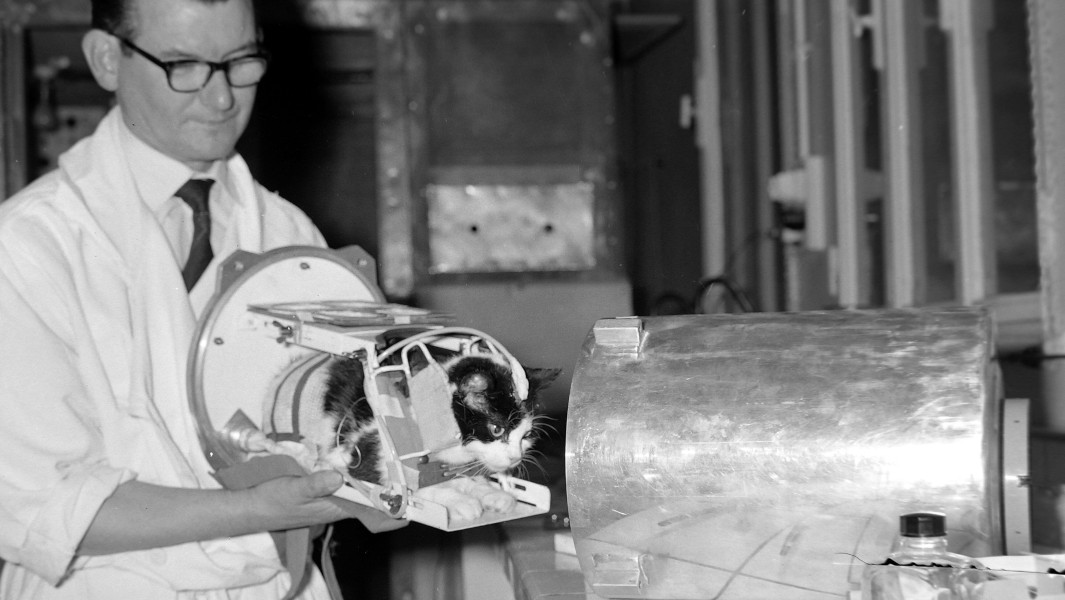The cat who reached the Milky Way: Anniversary of the first feline to fly to space

We all know stories about men who walked on the moon, or the brave astronauts who spent months dangling in zero-gravity – but before humans went to outer space, we sent some of our beloved pets first.
During the Cold War, countries competed for cultural capital through acts like the Space Race, where each superpower attempted to set milestones in space exploration. But before anyone could deem space safe for humans, they needed to study the impact of changing atmospheres on living creatures – for example, the US sent a mass of fruit flies out in a rocket in 1947, while the dog Laika was famously deployed in a spacecraft in 1957.
The French had a different approach, however – and in 1961, staff members at CERMA (Centre d’Enseignement et de Recherches de Médecine Aéronautique) rounded up 14 stray cats in Paris to find a fitting feline to be the first cat in space.
The strays were put through all types of tests, such as wiring their bodies with electrodes to monitor brain activity, and confining them in tight containers for long periods to observe their reactions. They were also tested in a centrifuge, which was designed to simulate the crushing G-forces during launch and re-entry.
The kitty that got selected was a black-and-white tuxedo cat, labelled as “C341” so handlers wouldn’t get too attached. And on 18 October 1963 – 62 years ago – her handlers brought her out to a slim Veronique AGI rocket at the Interarmy Special Vehicles Test Centre in the Algerian Sahara, and prepared her capsule for space travel.
First cat in space #Félicette to get memorial statue after successful crowdfund: https://t.co/zh8oh8K44Y pic.twitter.com/p7bQ6o4xou
— collectSPACE (@collectSPACE) November 17, 2017
That stray cat, who just a few years ago was prancing down Parisian streets and scavenging for dinner, lifted off into space at 8 a.m., and quickly shot past the atmospheric boundary at 9.5 g – which was around double the amount of g-force that the Apollo astronauts would later feel when making their own space voyage.
She then spent about five minutes experiencing the weightlessness of zero-gravity, before plummeting back down to Earth at 7 g, in a space flight that lasted a total of 13 minutes.
Miraculously, when the scientists cleared away the parachute attached to the capsule and opened the doors of the upside-down spacecraft, they found the cat completely unharmed – though slightly terrified.
Do you love learning about incredible pets? Read more stories like this one in our Animals section!
Dubbed “Astro-cat”, or Félix, after the famous cartoon cat from the silent era of cinema, the press was thrilled to see that an animal could safely make it to the stars, and they begged the scientists for more information about the cat, which they assumed was male.
But the scientists corrected them – this kitty wasn’t named Félix, nor was she C431 – she was a female, who had earned the name Félicette.
Many thanks to Geraldine Moser from @ISUnet for sending me photos of the statue of #Felicette the space cat, recently unveiled at a ceremony at the ISU campus in Strasbourg (pic 3 of 3, image credit: Photo Expression, ISU) pic.twitter.com/gjL76J5N6o
— Stuart Atkinson (@mars_stu) January 6, 2020
Sadly, Félicette was not destined to live out her days as a celebrated space pioneer. After two months back home, she was euthanized so that the scientists could investigate the ways in which her body was impacted by the journey. Unfortunately, the scientists revealed that no useful information was discovered from the autopsy, other than the fact that brain activity could be monitored remotely.
Nevertheless, in January 2020, a bronze statue of Félicette was erected at the International Space University in France, as a testament to the brave cat, and the countless other unknowing animals that gave up their lives for science.
The sculpture depicts Félicette with her neck craned up, looking at the stars that she once visited, with her tail curled protectively over the world.
Header image: Smith Archive / Alamy


